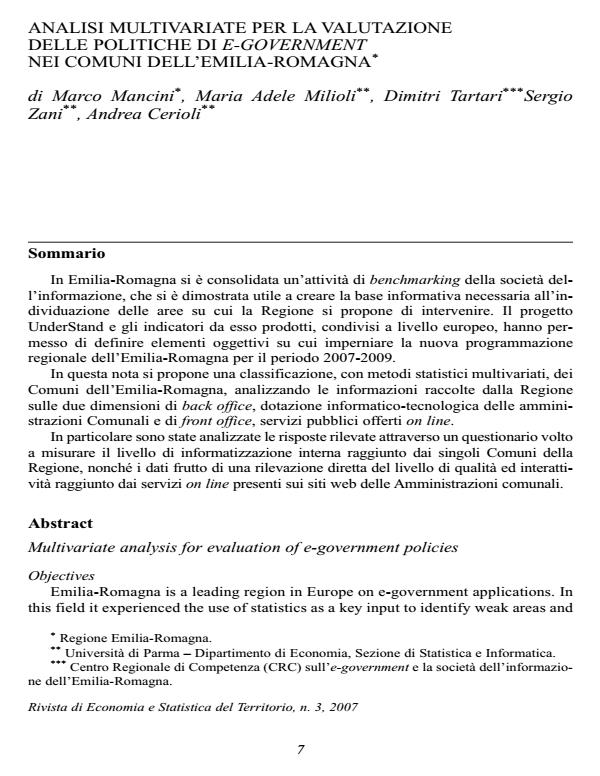Analisi multivariate per la valutazione delle politiche di e-government nei Comuni dell'Emilia Romagna
Journal title RIVISTA DI ECONOMIA E STATISTICA DEL TERRITORIO
Author/s Marco Mancini, Maria Adele Milioli, Dimitri Tartari, Sergio Zani, Andrea Cerioli
Publishing Year 2008 Issue 2007/3
Language Italian Pages 18 P. 7-24 File size 784 KB
DOI
DOI is like a bar code for intellectual property: to have more infomation
click here
Below, you can see the article first page
If you want to buy this article in PDF format, you can do it, following the instructions to buy download credits

FrancoAngeli is member of Publishers International Linking Association, Inc (PILA), a not-for-profit association which run the CrossRef service enabling links to and from online scholarly content.
Multivariate analysis for evaluation of e-government policies (by Marco Mancini, Maria Adele Milioli, Dimitri Tartari, Sergio Zani, Andrea Cerioli). Objectives Emilia-Romagna is a leading region in Europe on e-government applications. In this field it experienced the use of statistics as a key input to identify weak areas and to define policy priority. Thanks to the UnderStand project (European Regions UNDER way towards STANDard indicators for benchmarking information society) Emilia-Romagna has produced a set of indicators on ICT infrastructures, technology adoption, interactivity and quality of on-line public services, comparable at European level. This multivariate information is essential for the purpose of comparing local performances with respect to key e-government issues and for evaluating the impact of e-government policies. Major funding policies will be based on data gained through the UnderStand project, which need to be analyzed through integration of different data sources and application of appropriate multivariate statistical techniques. Methods and Results In this paper we present a cluster analysis of the municipalities of Emilia- Romagna, based on a set of back office and a set of front office indicators. Hierarchical and non-hierarchical clustering algorithms have been applied to each set of indicators to identify homogeneous groups of municipalities according to back and front office dimensions. The results have been compared to discover similarities between groups: the clusters of municipalities that are weak on ICT infrastructure and on interactivity of public services show good overlap and similarly for the strongest municipalities. Differences in e-government behaviour can be explained in terms of political and strategic attitudes. Conclusions The results of this paper show the importance of multivariate statistical methodology for the purpose of benchmarking the Information Society. Cluster analysis has been applied in the spirit of measuring for governing, as the ultimate goal of benchmarking is to provide policy makers with extensive information about the performance of e-government actions and policies.
Marco Mancini, Maria Adele Milioli, Dimitri Tartari, Sergio Zani, Andrea Cerioli, Analisi multivariate per la valutazione delle politiche di e-government nei Comuni dell'Emilia Romagna in "RIVISTA DI ECONOMIA E STATISTICA DEL TERRITORIO" 3/2007, pp 7-24, DOI: